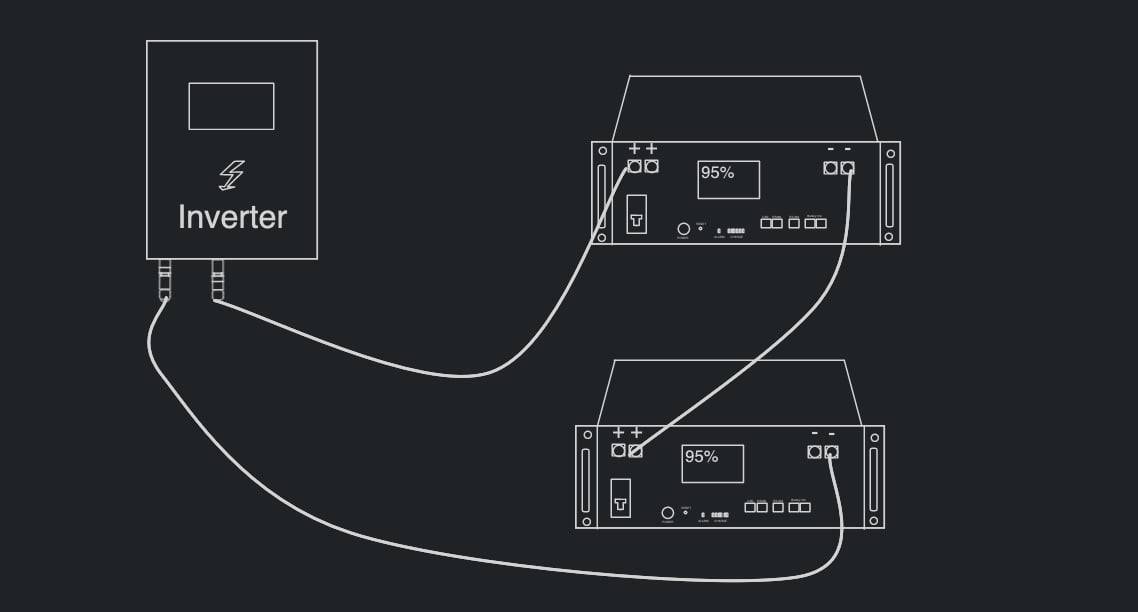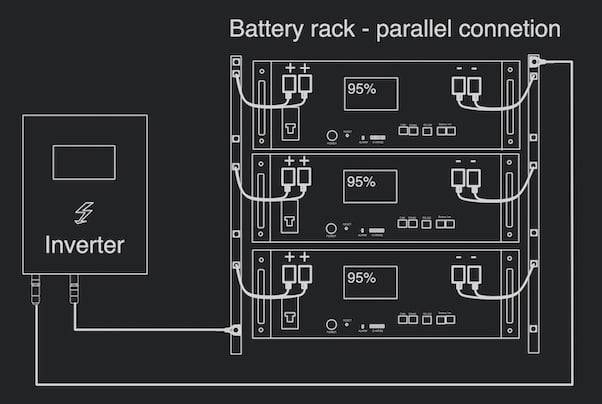Straightforward guide to connecting solar batteries, the tradeoffs involved and optimising for specific cases.

Sometimes a single battery is not enough for your home in one of few of the following ways:
- capacity is not large enough
- the voltage is too low for the inverter
- peak power is not enough
Fortunately you can solve for either of these with multiple batteries and the right connection type – series or parallel. This guide will show you how to connect batteries expanding their capacity, voltage or current based on your home’s requirements.
How to Connect Multiple Batteries?
You can connect batteries in series or parallel, with each option offering different tradeoffs. Much like connecting solar panels, it is a matter of what you are solving for, increasing the voltage or current. With batteries, though, there are a few basics you need to keep in mind before you proceed:
- Batteries use higher currents.
- Connecting batteries with different specifications is not advisable and can even be dangerous.
Select the Correct Cables Size
Ensure the cables leading the positive and negative pole from the battery to the inverter are equal in length and cross-section area. The same principle applies for cables connecting a battery to the next one.
Due to the high currents at which your battery operates you need to male sure you chose the cables accordingly. Special cables are required that can handle the peak discharge current of your batteries and potentially the new current after connecting more batteries.
For example, my home battery is rated at 100A and 48V. I have connected two such batteries in parallel to a 3.6kW inverter. At 48V, the inverter cannot draw more than 75A. So, I have opted for a 16mm2 (AWG 6) cables.
Connecting Batteries in Series

Connecting batteries in series increases the voltage and keeps the current constant. The voltage of the connected battery is equal to the sum of the voltage of each battery, and the current is equal to the current of the battery with the smallest current in the series. The Ah capacity of the batteries remains constant.
Let’s look at an illustrative example:
- We have two batteries rated at 100A, 50V, and 100Ah each.
- We can calculate the power for each battery – PP = U*I (voltage * current)50*00 = 5kW
- The voltage is 2*50 = 100V
- The current remains at 100A
- For two batteries, that is 100*100 = 10kW of power
- The capacity of the battery remains unchanged at 100Ah.
With this setup, we can power a consumer rated at 10Kw for 1h or a consumer rated at 5kW for 2h.
Understanding battery capacity is essential. While charge capacity is gauged in Ah, energy capacity is quantified in Wh . To determine the energy capacity, you multiply the voltage by the charge capacity: Energy Capacity (Wh)=Voltage (V)×Ah
The increased voltage of a series of batteries can be particularly useful when:
- Your inverter requires a voltage threshold that a single battery cannot meet.
- Your batteries are far from the inverter, and longer cables are required. Battery cables are thick and costly because they carry large currents. Increasing the voltage allows you to drop the current and thus reduce the required cross-section area of the required cables.
Connecting Batteries in Parallel

Connecting batteries in parallel increases the current and keeps the voltage constant. The current of the connected batteries is equal to the sum of the current of each battery, while the voltage remains equal to the voltage of a single battery in the parallel setup. The Ah capacity of the battery is added up.
Using a similar illustrative example:
- We have two batteries rated at 100A, 50V, and 100Ah each.
- We can calculate the power for each battery – PP = U*I (voltage * current)50*100 = 5kW
- The current is 2*100 = 200A
- The voltage remains at 50V
- For two batteries, that is 50*200 = 10kW of power
- The capacity of the batteries combined is 200Ah.
This means we can power a consumer rated at 10Kw for 1h (ideally) or a consumer rated at 5kW for 2h. Because of the increased current, our inverter can draw more power simultaneously.
The increased current of a parallel setup of batteries can be useful in cases:
- When the system needs to be easily scalable, allowing for the addition of more batteries to increase capacity.
Practical Aspects of Connecting Batteries in Parallel
Some battery manufacturers offer server racks designed to fit the batteries and host additional conveniences such as busbars and safety doors.

A rack in domestic solar energy systems offers better safety for pets and young children around the batteries. Some racks come with door locks for extra safety. The busbars come with wiring utilities which is a significant improvement given that battery connectors are large and require tight fitting for safety reasons.
When connected, batteries can suffer from Imbalance in State of Charge (SOC): Over time, individual batteries in parallel might not share the charge equally, leading to some batteries being overcharged while others remain undercharged. This is a function of how the battery nearest to the consumer tends to provide a larger current than the rest of the batteries. The effect is emphasised when large currents are drawn.
One of the ways to mitigate this is to use a diagonal connection. This is where you connect one of the poles at the top of the busbar and the other pole at the bottom. This will reduce the proximity effect of the battery closest to the consumer connection, but still, over time, imbalances will appear.
To reconcile differences over time, batteries need to be charged one by one up to 100% SOC. Having the connected in parallel can be a useful way to achieve this without having to manage any wiring if the batteries have a local shut-off switch.
Connecting Batteries in a Parallel-Series
Connecting batteries in a parallel-series configuration combines the characteristics of both series and parallel configurations. This means you’ll increase both the voltage and the current.
Let’s delve into an example with four batteries:
- We have four batteries, each rated at 100A, 50V, and 100Ah.
- First, we connect two batteries in series.
- This doubles the voltage to 100V while keeping the current at 100A.
- P = U*I (voltage * current)
- 100*100 = 10kW for each series of two batteries.
- Now, we connect these two series sets in parallel.
- This doubles the current to 200A while keeping the voltage at 100V.
- For the entire parallel-series setup:
- 100*200 = 20kW of power.
The capacity of the entire parallel-series setup is 200Ah.
The parallel series is a useful method where we benefit from the strengths of each of the other methods and limit their drawbacks as much as possible.









